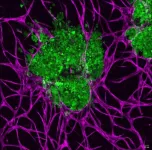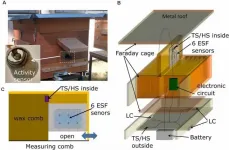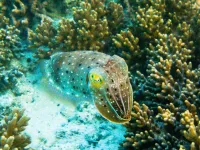Closing in on state-of-the-art semiconductor solar cells
2021-05-04
(Press-News.org) A synthetic approach that improves absorber layers in perovskite solar cells could help them achieve their full potential and draw closer to the performance of leading gallium arsenide devices.
Solar cells that rely on perovskite thin films to capture sunlight are the fastest growing photovoltaic technology. Cheaper and easier to manufacture and incorporate into devices than conventional semiconductors, lead halide perovskites also effectively absorb visible light and display long charge carrier diffusion lengths -- an indicator of their ability to maintain light-induced electrons and holes separation and facilitate charge transport.
Performance of solar cells hinges on absorber materials with a high-quality crystal structure and a narrow bandgap to maximize sunlight harvesting. This optimal bandgap range spans energies of 1.1 to 1.4 eV, which corresponds to near-infrared wavelengths.
Absorber layers containing polycrystalline lead halide perovskites have provided high-efficiency solar cells. Their performance, however, has been affected by considerable structural disorder and defects. Formamidinium lead triiodide features the smallest bandgap to date, but this bandgap exceeds the optimal range for single-junction devices. One way to reduce the bandgap of perovskites involves forming lead-tin alloys in the absorber, but this introduces crystal defects and instability.
Now, a team from KAUST has developed an approach using a microns-thick absorber layer consisting of perovskite single crystals to minimize the bandgap. The crystals contain a mixture of methylammonium and formamidinium organic cations.
The researchers incorporated the mixed-cation perovskite into unconventional inverted p-i-n solar cells, in which the absorber is sandwiched between an electron transport top layer and a hole transport bottom layer. The resulting solar cells exhibited an efficiency of 22.8 percent, surpassing the best-performing devices using single-crystal methylammonium lead triiodide.
"We had known that mixed-cation single-crystal absorbers could outperform single-cation absorbers due to their lower bandgap and superior optoelectronic qualities. However, this had not been realized before because of challenges in crystal growth and device integration," says Abdullah Alsalloum, a Ph.D. student in Osman Bakr's group.
The external quantum efficiency of the mixed-cation perovskite film, which measures its effectiveness when converting incoming light into charge carriers, shifted toward near-infrared wavelengths from that of polycrystalline formamidinium lead triiodide, consistent with its smaller bandgap. "By utilizing a thicker single-crystal absorber layer, we expanded the absorption range of the film so that it's very close to the optimal range," Alsalloum says.
The team is working on enhancing device performance and stability to get even closer to the top-performing gallium arsenide solar cells. "Future studies include optimizing device interfaces and exploring more favorable device structures," Alsalloum adds.
INFORMATION:
ELSE PRESS RELEASES FROM THIS DATE:
2021-05-04
A new Boston University School of Public Health (BUSPH) study has identified for the first time how the aryl hydrocarbon receptor (AhR), an environmental chemical receptor, drives immunosuppression in oral squamous cell carcinoma (OSCC)--and that its removal from malignant cells can result in tumor rejection.
Published in the journal Proceedings of the National Academy of Sciences, the study findings provide new insight into the biology of cancer immunosuppression, and identify a new target for cancer immunotherapy treatment.
Immune checkpoint inhibitors (immunotherapy drugs) are some of the most important treatments that have emerged for treating many cancers, including OSCC. Targeting immune checkpoint molecules such as PD-1, ...
2021-05-04
Measures to contain the Corona pandemic are the subject of politically charged debate and tend to polarize segments of the population. Those who support the measures motivate their acquaintances to follow the rules, while those who oppose them call for resistance in social media. But how exactly do politicization and social mobilization affect the incidence of infection? Researchers at the Max Planck Institute for Human Development have examined this question using the USA as an example. Their findings were published in Applied Network Science.
Limit crowds, keep a safe distance, and wear masks. Such non-pharmaceutical ...
2021-05-04
Cancerous tumors thrive on blood, extending their roots deep into the fabric of the tissue of their host. They alter the genetics of surrounding cells and evolve to avoid the protective attacks of immune cells. Now, Penn State researchers have developed a way to study the relationship between solid, difficult-to-treat tumors and the microenvironment they create to support their growth.
The method has the potential to act as a testbed for drugs and other anticancer treatments, according to Ibrahim T. Ozbolat, associate professor of engineering science and mechanics and biomedical engineering, who led the research. The details of the approach were published in Advanced Biology.
Using ...
2021-05-04
Despite human inventiveness and ingenuity, we still lag far behind the elegant and efficient solutions forged by nature over millions of years of evolution.
This also applies for buildings, where animals and plants, have developed extremely effective digging methods, for example, that are far more energy-efficient than modern tunnelling machines, and even self-repairing foundations that are unusually resistant to erosion and earthquakes (yep, we're talking about roots here).
Researchers from all over the world are therefore seeking inspiration in nature to develop the buildings of the future, and researchers from Aarhus University ...
2021-05-04
Honeybees have a complex communication system. Between buzzes and body movements, they can direct hive mates to food sources, signal danger, and prepare for swarming - all indicators of colony health. And now, researchers are listening in.
Scientists based in Germany - with collaborators in China and Norway - have developed a way to monitor the electrostatic signals that bees give off. Basically, their wax-covered bodies charge up with electrostatic energy due to friction when flying, similar to how rubbing your hair can make it stand on end. That energy then gets emitted during communications.
"We were thrilled by the ...
2021-05-04
The majority of top-rated fertility apps collect and even share intimate data without the users' knowledge or permission, a collaborative study by Newcastle University and Umea University has found.
Researchers are now calling for a tightening of the categorisation of these apps by platforms to protect women from intimate and deeply personal information being exploited and sold.
For hundreds of millions of women fertility tracking applications offer an affordable solution when trying to conceive or manage their pregnancy. But as this technology grows in popularity, experts have revealed that most of the top-rated fertility apps collect and share sensitive ...
2021-05-04
T-cell acute lymphoblastic leukemia (T-ALL) is a very aggressive type of blood cancer. It is relatively rare but still draws a lot of attention as it mostly develops in children under the age of 20. The standard treatment for T-ALL involves heavy chemotherapy procedures, which result in favorable outcomes with an overall survival of 75% after 5 years.
However, some patients do not respond to this treatment, or they only respond for a short period, after which the disease grows back. These patients therefore need alternative therapies.
Researchers from the Faculty of Health and Medical Sciences, University of Copenhagen, have now identified a combination treatment, which could potentially benefit patients ...
2021-05-04
University of Bristol research into octopus vision has led to a quick and easy test that helps optometrists identify people who are at greater risk of macular degeneration, the leading cause of incurable sight loss.
The basis for this breakthrough was published in the latest issue of the Journal of Experimental Biology and describes new technology developed by lead researcher, Professor Shelby Temple, to measure how well octopus- which are colour-blind - could detect polarized light, an aspect of light that humans can't readily see. Using this novel technology, the research team showed that octopus have the most sensitive polarization vision system of any animal tested to date. Subsequent research ...
2021-05-04
When COVID-19 patients began filling up ICUs throughout the country in 2020, health care providers faced difficult decisions. Health care workers had to decide which patients were most likely to recover with care and which were not so resources could be prioritized.
But a new paper from the University of Georgia suggests that unconscious biases in the health care system may have influenced how individuals with intellectual disabilities were categorized in emergency triage protocols.
The state-level protocols, while crucial for prioritizing care during disasters, frequently ...
2021-05-04
(Boston)--If you come from a family where people routinely live well into old age, you will likely have better cognitive function (the ability to clearly think, learn and remember) than peers from families where people die younger. Researchers affiliated with the Long Life Family Study (LLFS) recently broadened that finding in a paper published in END ...
LAST 30 PRESS RELEASES:
[Press-News.org] Closing in on state-of-the-art semiconductor solar cells


